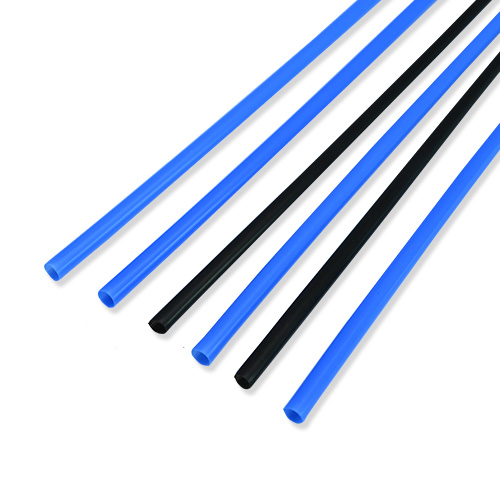FEP Industrial Fluoropolymer Tubing Manufacturers: Technological Innovation and Market Trends
FEP (perfluorinated ethylene propylene) fluoropolymer tubing, known for its excellent chemical stability and high-temperature resistance, is widely used in various industries. As the global demand for high-quality materials continues to grow, FEP tubing manufacturers are pushing technological innovation and striving to meet the market's needs for customization, sustainability, and high-performance materials.

Unique Advantages of FEP Tubing
One of the key advantages of FEP tubing is its outstanding performance in high-temperature and harsh chemical environments. FEP materials typically withstand temperatures up to 260°C, or even higher, making them an ideal choice for high-temperature applications. Compared to other fluoropolymers like PTFE, FEP tubing offers similar chemical stability but with significant advantages in transparency and processability. This makes FEP tubing uniquely positioned in markets that require high transparency and precise processing, such as in semiconductor, electronics, and high-end chemical fluid transport applications.
In industries like chemicals and pharmaceuticals, FEP tubing is not only resistant to corrosive chemicals but also ensures the purity of the transported fluids. Compared to traditional metal tubing, FEP's non-toxicity and non-adhesive properties make it indispensable for fluid transport systems in these sectors.
Expanding Applications Across Industries
With ongoing technological advancements, the applications of FEP tubing continue to expand, particularly in the chemical, electronics, and medical industries. For the chemical industry, FEP tubing can withstand the corrosion of hazardous chemicals, making it ideal for transporting substances like chlorine gas and hydrofluoric acid. In these sectors, the corrosion resistance and stability of FEP tubing ensure long-term reliability even under extreme conditions.
In the electronics industry, FEP tubing's electrical insulation properties are a major advantage. Due to its excellent electrical insulating and antioxidant properties, FEP tubing is widely used in high-end cables and transmission lines, especially in high-tech industries involving precision instruments and equipment. Additionally, FEP tubing’s transparency and low friction coefficient make it irreplaceable in certain delicate, precise operations.
Production Processes and Technological Innovation
The production of FEP tubing typically involves extrusion, stretching, and annealing processes. Temperature and pressure control are crucial during manufacturing. Through extrusion, FEP tubing is uniformly shaped, ensuring consistent wall thickness and strength. The stretching process increases the strength and flexibility of the tubing, allowing it to meet more complex application demands.
Leading FEP tubing manufacturers have adopted advanced production equipment and technologies, such as laser welding techniques, to produce seamless FEP tubing. This not only enhances the tubing's durability but also ensures longer service life. During the annealing process, manufacturers pay special attention to the smoothness of both the inner and outer surfaces of the tubing, which not only guarantees the tubing’s reliability during use but also helps to resist long-term thermal aging and chemical corrosion.
Market Competition and Development Trends
The global FEP tubing market is highly competitive, with many manufacturers striving to maintain a leading position through continuous innovation and process optimization. According to recent industry reports, the FEP tubing market is expected to continue growing, especially in the fields of chemical transport, medical devices, and high-end electronics. The increase in global demand and reliance on high-performance materials is driving manufacturers to improve their technological capabilities.
In recent years, demand for FEP tubing has not been limited to traditional industrial applications. Many manufacturers have started to focus on environmental regulations and sustainability issues. As global environmental standards become stricter, manufacturers need to find ways to reduce resource waste and energy consumption while maintaining product quality. Through recycling and the use of eco-friendly materials, the sustainability of FEP tubing has become a new focus for manufacturers.
In the future, FEP tubing manufacturers may explore deeper into smart manufacturing and automated production. By leveraging advanced IoT technologies and big data analytics, manufacturers can monitor production parameters in real-time and adjust processes accordingly, further improving production efficiency and product quality.
The Rise of Customization Services
With the increasing diversification of market demands, more and more manufacturers are offering customization services, especially in high-end application fields. For instance, certain clients may need FEP tubing with specific dimensions, temperature ranges, or colors, and manufacturers can tailor solutions based on these requirements. This trend is particularly evident in the electronics and aerospace industries. In these fields, FEP tubing must not only meet high-performance requirements but also be precisely designed and processed according to the specific working environment.
Customization services not only meet the varying needs of customers but also drive manufacturers to further improve their technological research and production processes. By offering customized products, FEP tubing manufacturers can expand their market share and enhance brand influence.
Environmental Protection and Sustainability
FEP tubing, as an eco-friendly material, holds an important position in the global green trends due to its durability and recyclability. FEP tubing has a long service life and can maintain its performance even in extreme environments. This means that FEP tubing retains high recycling value even after its application ends.
Manufacturers are continuously optimizing their processes to reduce pollution and resource waste during production, while adopting eco-friendly raw materials and energy sources. With the growing stringency of global environmental regulations, many manufacturers are actively taking environmental measures in product design and manufacturing to meet increasingly stringent environmental requirements.
Conclusion
FEP Industrial Fluoropolymer Tubing, with its exceptional chemical stability, high-temperature resistance, and electrical insulation properties, has become a key player in various industries. As global demand for high-performance materials continues to rise, FEP tubing manufacturers are driving technological innovations and offering customized services to meet the unique needs of different industries. At the same time, sustainability and environmental protection have become important focuses for the future. Over the next few years, the FEP tubing market will continue to grow, driving breakthroughs for manufacturers in both technology and market domains.




